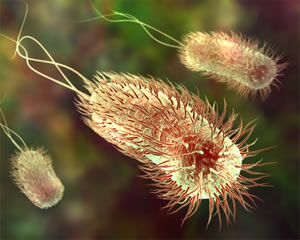Difference between Prokaryotes and Eukaryotes
Key difference: The main difference between prokaryotes and eukaryotes is based on their different size and cell structure.
All living organisms can be divided into two groups based on the fundamental structure of their cells. Accordingly, they can be classified as the prokaryotes and eukaryotes. This article differentiates between the two classes of organisms.
 Prokaryotes are organisms made up of cells that lack a cell nucleus or any membrane-encased organelles. This means that they have no nucleus. Also, the genetic material i.e. DNA, in prokaryotes is not bound within a nucleus. The term prokaryote is derived from the Greek word “prokaryote”, which means before nuclei.
Prokaryotes are organisms made up of cells that lack a cell nucleus or any membrane-encased organelles. This means that they have no nucleus. Also, the genetic material i.e. DNA, in prokaryotes is not bound within a nucleus. The term prokaryote is derived from the Greek word “prokaryote”, which means before nuclei.
Most prokaryotes are made up of just a single cell and are called as unicellular organism. Here, reproduction takes place through binary fission. Also, there are a few prokaryotes which are made of a collection of cells and are called as multi-cellular organisms. The prokaryotes are divided into two groups, they are:
- Bacteria
- Archaea

Eukaryotes are organisms made up of cells that possess a membrane-bound nucleus as well as membrane-bound organelles. The term eukaryote is derived from the Greek word “œeukaryoteâ”, which means true or good nuclei. This cell includes all life kingdoms except ‘monera’. Here, the division of cells takes place in two ways:
- Mitosis - one cell divides to produce two genetically identical cells
- Meiosis - where sexual reproduction is required.
These organisms hold the genetic material in their cells. The genetic material in eukaryotes is contained within a nucleus in a cell. The DNA of these organisms is structured and is organized into chromosomes. Eukaryotic organisms may be multi-cellular or single-celled organisms. All animals are considered as eukaryotes. They can be further classified as:
- Plant cells
- Animal cells
Comparison between Prokaryotes and Eukaryotes:
|
|
Prokaryotes |
Eukaryotes |
|
Definition |
These are organisms made up of cells that lack a cell nucleus or any membrane-encased organelles. |
These organisms made up of cells that possess a membrane-bound nucleus as well as membrane-bound organelles. |
|
Nucleus |
It has no nucleus. |
It has a true nucleus, bounded by double membrane. |
|
DNA arrangement |
It has a circular loop. |
It is linear. |
|
Size |
Small cells ( < 5 µm) |
Large cells ( < 10 µm) |
|
Cell |
Always unicellular |
Mostly multi-cellular |
|
Cell wall |
Usually present; chemically complex in nature |
When present, chemically simple in nature |
|
Protein |
It does not contain protein in its DNA. |
It contains proteins in the DNA to form chromatin. |
|
Ribosome |
It contains small ribosomes. |
It contains large ribosomes. |
|
Cytoplasm |
No cytoskeleton |
Always have cytoskeleton |
|
Cell division |
Cell division is by binary fission |
Cell division is by mitosis |
|
Reproduction |
Reproduction is always asexual |
Reproduction is asexual or sexual |
|
Metabolic pathways |
Huge variety of metabolic pathways |
Common metabolic pathways |
|
Flagella |
Consist of two protein building blocks |
It is complex in nature and consist of multiple microtubules |
|
Multi-cellular forms |
Rare |
Common with extensive tissue formation |
|
Mesosomes |
They perform functions of golgi-bodies and mitochondria, and also help in separation of chromosomes. |
Not present |
|
Plasma membrane |
No carbohydrates and lacks sterols |
Sterols and carbohydrates, both are present |
|
Glycocalyx |
Present as a capsule or slime layer |
Present in some cells which lack a cell wall |
|
Example |
Bacteria and Archaea |
Animal cells and plant cells |
Image Courtesy: manwiththemuckrake.com, dedeep.com









Add new comment